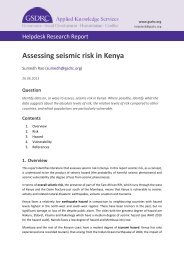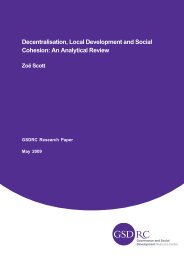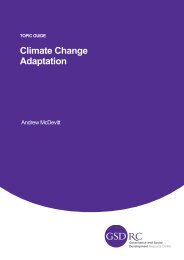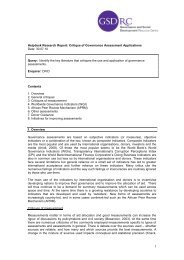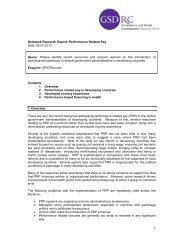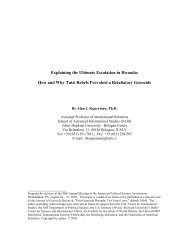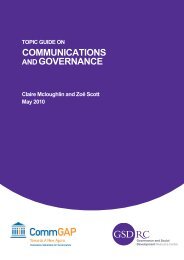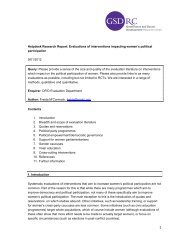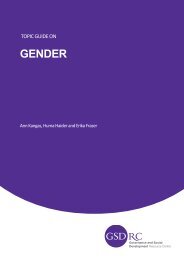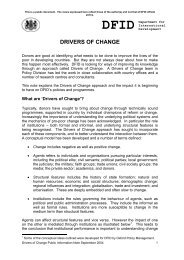Measuring women's economic empowerment - GSDRC
Measuring women's economic empowerment - GSDRC
Measuring women's economic empowerment - GSDRC
You also want an ePaper? Increase the reach of your titles
YUMPU automatically turns print PDFs into web optimized ePapers that Google loves.
Helpdesk Research Report: <strong>Measuring</strong> Women’s Economic EmpowermentDate: 13.08.2010Query: What literature exists on impact evaluation in relation to <strong>women's</strong> <strong>economic</strong><strong>empowerment</strong> in developing countries and what does it tell us about theories of change,indicators and impact measures?What impact evaluations have been done on <strong>women's</strong> <strong>economic</strong> <strong>empowerment</strong> programmes andwhat results do they show? What indicators have been used to measure success / progress, andif available, what Theory of Change / Intervention Logic has been used to design theinterventions?Enquirer: DFID AsiaContents1. Overview2. <strong>Measuring</strong> women’s <strong>empowerment</strong>- Conceptual frameworks- Methodologies and guidance3. Impact evaluations- Meta-evaluations and syntheses- Selected programme/project evaluations4. Further information1. OverviewScopeIn order to offer a holistic view as possible in the time available this report includes a selection ofliterature on the broad challenges of measuring <strong>empowerment</strong>, as well as work which specificallyevaluates <strong>economic</strong> <strong>empowerment</strong> interventions.Part one presents a small selection of the large body of literature on the methodologicalchallenges of measuring women‘s <strong>empowerment</strong> and goes on to identify a range of approacheswhich have been developed to measure the impact of <strong>empowerment</strong> in practice.Part two presents specific impact studies of women‘s <strong>economic</strong> <strong>empowerment</strong> programmes. Dueto the large volume of available literature, the focus is on meta-evaluations and syntheses ofevaluation findings although a small selection of project-level evaluations is also included. Insome cases a snapshot of the evaluation methodology and indicators used is provided. Due totime constraints, the emphasis here is on programmes relating to private sector development andwomen‘s entrepreneurship, access to employment, and access to finance. Other interventionssuch as gender-responsive budgeting and social protection, although relevant, are not included.1
It is also worth noting that the report does not include discussion of global <strong>empowerment</strong> indicessuch as the Gender Empowerment Measure (GEM) or the Gender-related Development Index(GDI).Concepts and impact measuresThere is no single definition of women‘s <strong>empowerment</strong> in the literature. Empowerment isvariously conceptualised as a process, an end-state, and a capacity (Kabeer, 2001; Malhotra,2002; Alsop et al., 2005; Martinez, 2006). It is generally accepted however that efforts to measurewomen‘s <strong>empowerment</strong> need to consider different levels (micro/macro, individual/collective),different spheres (<strong>economic</strong>, political, social), different temporal scales (often beyond the lifetimeof a single programme) and must be sensitive to social context.In much the same way, there is no standard definition of women‘s <strong>economic</strong> <strong>empowerment</strong> andthe term is often used loosely. From the literature reviewed for this report, it would appear that themajority of efforts to measure women‘s <strong>economic</strong> <strong>empowerment</strong> programmes focus primarily onquantitative outcomes - such as increased access to credit or increased business revenue - evenwhere the stated objectives include broader <strong>empowerment</strong> goals. Whilst some evaluationsinclude variables to show that women have not been disempowered, few succeed in showingthat specific aspects of women‘s power have actually increased (e.g., more household resourcesdedicated to women‘s consumption and personal time, increased women‘s decision making andcontrol over household resources, increased autonomy). As is often noted in the literature,positive outcomes in financial terms do not necessarily equate to <strong>empowerment</strong> (Kabeer 2005)and can even have disempowering effects (Martinez, 2006).One recent attempt at developing a conceptual framework for evaluating <strong>economic</strong> <strong>empowerment</strong>is the International Center for Research on Women‘s (ICRW) Results-based Initiative (ICRW,n.d.). Another promising initiative, although not focussed exclusively on <strong>economic</strong> <strong>empowerment</strong>,is Care International‘s Strategic Impact Inquiry on Women‘s Empowerment (CARE, 2006).Approaches to measuring women‘s <strong>empowerment</strong> in more broad terms are of course relevant toevaluating <strong>economic</strong> <strong>empowerment</strong>, especially given the limitations of existing frameworks. Suchapproaches generally involve defining what is meant by <strong>empowerment</strong> and identifying thedifferent elements which make up this definition. These elements are variously defined as:resources, agency and achievements (Kabeer 2001); control over resources and agency,(Malhotra, 2002); agency and opportunity structure (Alsop et al, 2005); agency, structures andrelations (CARE, 2006); assets, knowledge, will and capacity (Charlier and Caubergs, 2007). Inmost cases, these elements are then broken down into sub-dimensions with associated indicatorsand sources of measurement. There are, however, also examples of more qualitative approachessuch as appreciative enquiry and qualitative self-assessment (UNIFEM, 2008; Jupp, D., 2010).2. <strong>Measuring</strong> women’s <strong>empowerment</strong> – conceptual frameworks, methodologies andindicatorsConceptual frameworksBRIDGE, 2007, ‘Gender and Indicators’, Cutting Edge Pack, Bridge, IDS, Brightonhttp://www.bridge.ids.ac.uk/go/bridge-publications/cutting-edge-packs/gender-and-indicators/This report explains what is meant by gender-sensitive indicators and measurements of change.It makes the case for gender-sensitive measurements and outlines how to go about measuring inpractice. Section 4.2. (pp.26-27) looks specifically at measuring <strong>empowerment</strong>. According to theanalysis, <strong>empowerment</strong> combines not only observable action, but also the meaning, motivationand purpose attributed to such action. As such, women‘s <strong>empowerment</strong> must be measured along2
a number of indicators. Moreover, purely quantitative indicators may not be sensitive enough tocapture the nuances of gendered power relations inherent in <strong>empowerment</strong> processes; nor canthey measure an individual‘s (subjective) sense of agency or self-worth. In order to understandthe socio-cultural context within which social interaction and gender relationships take place, itmay be useful to use in-depth qualitative methods. Approaches to measuring women‘s<strong>empowerment</strong> must also take into account the fact that <strong>empowerment</strong> can be a slow process ofchange.The report identifies a key challenge as balancing the need for both universal standards tomeasure <strong>empowerment</strong> and context-sensitive indicators. One approach is to use multi-levelindicators, where broader-level indicators might be applicable across a range of contexts, whileindicators at the community and household level might be adapted for specific contexts.See also: Esplen, E. Heerah, S. and Hunter, C., 2006, Women's Empowerment: AnAnnotated Bibliography, Bridge and Pathways of Women's Empowerment RPC, IDS,Brighton http://www.bridge.ids.ac.uk/reports/bb14.pdfThis bibliography gathers together a range of resources which discuss <strong>women's</strong> <strong>empowerment</strong>from different perspectives in order to provide an accessible introduction to key concepts,approaches and debates. Part 4 (pp 11-12) summarises the literature on approaches tomeasuring and evaluating <strong>women's</strong> <strong>empowerment</strong>.Kabeer, N., 2001, ‘Resources, Agency, Achievements: Reflections on the Measurement ofWomen's Empowerment’, pp 17-59 in Discussing Women's Empowerment - Theory andPractice’, Swedish International Development Cooperation Agency, Stockholm, Swedenhttp://www.sida.se/shared/jsp/download.jsp?f=SidaStudies+No3.pdf&a=2080This paper discuses attempts to construct indicators of women‘s <strong>empowerment</strong>, focussing inparticular on the meanings given to these measures and values embedded within them. Kabeerdefines <strong>empowerment</strong> as ―the process by which those who have been denied the ability to makestrategic life choices acquire such an ability‖ (p 19). She argues that there is a wide gap betweenthis understanding of <strong>empowerment</strong> and the more instrumentalist definition attached to efforts tomeasure and quantify <strong>empowerment</strong>. In her analysis, the ability to exercise choice incorporatesthree inter-related dimensions: resources (defined broadly to include not only access, but alsofuture claims, to both material and human and social resources); agency (including processes ofdecision making, as well as less measurable manifestations of agency such as negotiation,deception and manipulation); and achievements (well-being outcomes). The paper concludes thatthese three dimensions of choice are indivisible in determining the meaning of an indicator andhence its validity as a measure of <strong>empowerment</strong>.Malhotra, Anju, et al., 2002, ‘<strong>Measuring</strong> Women’s Empowerment as a Variable inInternational Development’, World Bank, Gender and Development Group, Washington DChttp://hdr.undp.org/docs/network/hdr_net/GDI_GEM_<strong>Measuring</strong>_Womens_Empowerment.pdfThis paper presents a review of theories and strategies to foster <strong>women's</strong> <strong>empowerment</strong> in thedevelopment context. It defines <strong>empowerment</strong> as the ability of people to make strategic choicesin areas that affect their lives. Two key factors in the process of <strong>empowerment</strong> are identified:control over resources (the conditions for <strong>empowerment</strong>) and agency (the ability to formulatechoices).Section one of the paper outlines the conceptual framework, whilst section two discusses how<strong>empowerment</strong> can be measured in practice, with an overview of various frameworks which cover<strong>economic</strong>, socio-cultural, familial, legal, political and psychological dimensions. It identifies thefollowing elements of <strong>economic</strong> <strong>empowerment</strong> at three levels:3
Household‣ women‘s control over income;‣ relative contribution to family support;‣ access to and control of family resources.Community‣ women‘s access to employment;‣ ownership of assets and land;‣ access tocredit;‣ involvement and/or representation in local trade associations;‣ access to markets.Broader access‣ women‘s representation in high paying jobs;‣ women CEOs;‣ representation of women‘s <strong>economic</strong> interests in macro<strong>economic</strong> policies, state andfederal budgets.The report argues that in practice, measuring <strong>empowerment</strong> depends on the establishment ofuniversal standards (such as human rights), but at the same time must allow for indicators whichare sensitive to context. Recommendations include the need todevelop a framework that can beused across settings, and to address <strong>empowerment</strong> at the mezzo/community level as well as atthe level of the macro (legal/political) and micro (family).Narayan, D., 2005, ‘<strong>Measuring</strong> Empowerment. Cross-Disciplinary Perspectives’, WorldBank, Washingtonhttp://books.google.co.uk/books?id=BzXyApyTGOYC&dq=<strong>Measuring</strong>+Empowerment.+Cross-Disciplinary+Perspectives&printsec=frontcover&source=bn&hl=en&ei=phFgTNjPHKH20wTy7u3UBQ&sa=X&oi=book_result&ct=result&resnum=4&ved=0CCwQ6AEwAw#This book brings together a range of perspectives from economists, anthropologists, sociologists,psychologists, demographers, and political scientists on the challenge of measuring<strong>empowerment</strong>.Alsop, R. (ed), 2004, ‘Power, Rights, and Poverty: Concepts and Connections’, a workingmeeting sponsored by DFID and the World Bank, March 23–24http://siteresources.worldbank.org/INTEMPOWERMENT/Resources/PPFinalText.pdfThis volume brings together background materials and discussions from a two-day workingmeeting on ―Power, Rights, and Poverty Reduction‖ held jointly by the World Bank and the UnitedKingdom Department for International Development in March 2004, and includes papers whichdiscuss the challenges of measuring <strong>empowerment</strong>.4
access to markets, linking agricultural productivity and food security, and making gender centralto private-sector human resources management.Each RBI has two parts. The first involves implementing interventions that can be replicated andscaled up, reaching a broad cross-section of women over time. The RBI must yield relativelyquick results, and have high potential <strong>economic</strong> benefits for participants, their families andcommunities. The second component entails designing and undertaking a rigorous impactevaluation so that lessons can be captured and applied to current and future projects. Sixcountries have been chosen for RBIs. In each, projects are linked to priority national strategies for<strong>economic</strong> development and gender equality. They aim to expand existing national capacities, andstrengthen implementation of progressive policies and laws.For further information visit the ICRW website: http://www.icrw.org/where-we-work/measuringimpact-women%E2%80%99s-<strong>economic</strong>-development-programsCharlier, S. and Caubergs, L., 2007, ‘The Women Empowerment Approach: aMethodological Guide, Commission on Women and Development, Brusselshttp://www.atol.be/docs/publ/gender/women_<strong>empowerment</strong>_approach_CVO.pdfThis dynamic <strong>empowerment</strong> methodology, developed by the ―Gender and Indicators‖ workinggroup of the Commission on Women and Development creates flexible indicators fordevelopment programming in local contexts.The paper first sets out the theoretical foundations that underpin the concept of <strong>empowerment</strong>, asconceived by <strong>women's</strong> movements from the South and key thinkers on the issue. It explains theimportant attributes that determine <strong>empowerment</strong> levels: assets, knowledge and know-how, willand capacity. It also explains concepts including the circles of <strong>empowerment</strong>; and the individualand collective levels of <strong>empowerment</strong>.It then outlines how to measure <strong>empowerment</strong> by establishing a baseline of <strong>women's</strong> assets,knowledge, will and capacity. This then enables the formulation of indicators to follow-up onthroughout the programme, including improvements in self-esteem, increased income and how itis spent, enhanced knowhow and new capacities. In turn, this informs what the programme inputs(strategies, resources and activities) should be for improving <strong>economic</strong>, human and socialresources, such as material support, training and setting up networks.The methodology also enables an evaluation of the programme that can determine improvementsin quality of life for individuals and the building of social justice in terms of gender equality. Thedocument illustrates how the approach works, by referring to contextualised versions used inBolivia, the Congo, Guinea and Niger.Alsop, R. and Heinsohn, N., 2005, ‘<strong>Measuring</strong> Empowerment in Practice: StructuringAnalysis and Framing Indicators’, World Bank Policy Research Working Paper3510, Washington DC http://wwwwds.worldbank.org/external/default/WDSContentServer/IW3P/IB/2005/03/06/000090341_20050306094734/Rendered/PDF/wps3510.pdfThis paper sets out the World Bank‘s analytic framework for measuring and monitoring<strong>empowerment</strong> processes and outcomes. The framework can be used to measure <strong>empowerment</strong>at both the intervention level and the country level, as a part of poverty or governance monitoring.Empowerment is defined as a person's capacity to make effective choices - that is, the capacityto transform choices into desired actions and outcomes. The extent or degree to which a personis empowered is influenced by personal agency (the capacity to make purposive choice) and6
opportunity structure (the institutional context in which choice is made). Asset endowments areused as indicators of agency. These assets may be psychological, informational, organizational,material, social, financial, or human. Opportunity structure is measured by the presence andoperation of formal and informal institutions, including the laws, regulatory frameworks, andnorms governing behaviour. Degrees of <strong>empowerment</strong> are measured by the existence of choice,the use of choice, and the achievement of choice. A tabular summary of the framework is givenon p14.The paper also shows how the framework was applied in four development interventions (theEthiopia Women‘s Development Initiatives Project, the Nepal Rural Water and Sanitation Project,the Honduras Community-Based Education Project, and the Mexico Lifelong Learning Project.Annex 2 (pp 43-58) presents agency, opportunity structure, and <strong>empowerment</strong> indicators thatwere developed to measure <strong>empowerment</strong> in each project.Annex 1 (pp 34-42) summarises approaches to <strong>empowerment</strong> from a series of studies. For eachstudiy information is provided on the Location of the study, definition of <strong>empowerment</strong>, themeasurement concept, data sources and focus.See also: World Bank, 2007, ‘Empowerment in Practice: Analysis and Implementation AWorld Bank Learning Module’, World Bank, Washingtonhttp://siteresources.worldbank.org/WBI/Resources/EmpowermentLearningModulebody.pdfThis learning module provides a tool for understanding the concept of <strong>empowerment</strong> and forusing it in development practice. The module offers a framework for conceptualizing<strong>empowerment</strong> and takes participants through case-based exercises that apply the framework tothe analysis, design, implementation, and monitoring of development policies and operations.Jupp, D., Ibn Ali, S. with Barahona, C., 2010, ‘<strong>Measuring</strong> Empowerment? Ask Them.Quantifying qualitative outcomes from people’s own analysis’ Sida, Swedenhttp://sidapublications.citat.se/interface/stream/mabstream.asp?filetype=1&orderlistmainid=2925&printfileid=2925&filex=3917508864750This report describes a participatory approach to measuring <strong>empowerment</strong> at the project level,developed in Bangladesh, based purely on qualitative self-assessment. The approach embracesthe idea that different aspects of <strong>empowerment</strong> may be achieved asymmetrically and at adifferent pace in different contexts, by recognising and quantifying all positive changes. Thereport explains the evolution and application of the evaluation tool and provides examples of howthe data generated can be used for the purposes of results-based management and how it canbe replicated in other programmes.The approach can be divided into two distinct parts; the first is led by insiders themselves and thesecond comprises collation and analysis of the insider-generated data by outsiders. In part 1,perceptions and insights are gathered from people regarding the benefits and motivationsinvolved in project participation. These processes can use participatory rural appraisal (PRA)approaches, drama, story-telling, songs, picture making, conversations and debate to generatestatements which describe their experience. These descriptive statements are clustered and rewordedin order to be meaningful to all project participants. Each year project participants sittogether at a suitable time to review each indicator, clarifying and discussing it and, finally,scoring according to whether they feel they have or have not achieved it. The process isfacilitated by members of other groups. As the process is self-facilitated there is no deference tooutsiders. As there are no material benefits to be gained from exaggerating performance, thescoring is realistic. The assessment process is regarded by group members as entirely for theirown benefit and an important exercise, which as far as they are concerned is where it ends.7
Part 2 is done externally by project staff in order to meet the demands of results-basedmanagement. The results of the self assessments are collected with the permission of thegroups, and are aggregated and processed to provide analysis for programme design, staffperformance assessment and to satisfy donors‘ need for reliable quantitative information. Thedata is categorised and weighted to enable trends, distributions and correlations to be reviewed.INTRAC, 2000, ‘The Monitoring And Evaluation Of Empowerment A Resource Document’,International NGO Training and Research Centre, Oxfordhttp://intrac.client.fatbeehive.com/docs/OPS26final.pdfThis resource document presents an overview of the common approaches to <strong>empowerment</strong> indevelopment, key issues for monitoring and evaluating, and methods and instruments forcollecting information. It essentially aims to answer the question: ―‗how can we know whenpreviously powerless, marginalised or disadvantaged groups have been empowered and thusbetter able to confront and deal with those forces which influence their development?‖Mayoux, L., and Hartl, M., 2009, ‘Gender and Rural Microfinance: Reaching andEmpowering Women. A Guide for Practitioners’, IFAD, Romehttp://www.ifad.org/gender/pub/gender_finance.pdfThis guide is intended as an overview of gender issues for rural finance practitioners. Ofparticular interest here is appendix D (p 69) which presents a gender impact checklist. How thechecklist is used will depend on purpose, resources and context. It can be used on its own todesign quantitative, qualitative or participatory assessments of varying length. It can also be usedto complement poverty impact-assessment questionnaires or to inform the integration of genderissues into social performance management or participatory market research. The guide stressesthat it is important to:‣ include detailed consideration of context and not assume that any signs of <strong>empowerment</strong>are due to microfinance. In particular, women should not be viewed as ‗passive victims ofsubordination‘, but as active agents constantly negotiating and addressing the challengesthey face;‣ look at the differential impacts of various types of financial products and service delivery,if the assessment is to be of any use in designing such products and services;‣ disaggregate information to look at diverse impacts on women from various social and<strong>economic</strong> backgrounds, in particular possible varied patterns of impact on very poorwomen and women from marginalized communities;‣ compare impacts on women with those on men, and look at the reasons for anydifferences and the implications for designing more gender-equitable products andservices.AfDB/ILO, 2007, ‘Assessing the Enabling Environment for Women in Growth Enterprises:An AfDB/ILO Integrated Framework Assessment Guide’, Asian Development Bank, Manilahttp://www.ilo.org/wcmsp5/groups/public/---ed_emp/---emp_ent/documents/publication/wcms_116163.pdf\This guide is based around the AfDB/ILO Integrated Framework for assessing the enablingenvironment for the growth of women‘s enterprises. It is based on the proposition that if womenare equipped with the necessary resources, skills and opportunities to start stronger businesses,and if they are more readily able to pursue the growth potential of these enterprises, the economywill benefit from reduced poverty, from greater employment and from <strong>economic</strong> growth. Thewomen entrepreneurs will be able to grow their own enterprises and become more significantactors in national economies. In addition, avenues will be opened for the greater social inclusion8
of women in the public domain, greater gender equality, and enhanced <strong>economic</strong> <strong>empowerment</strong>of women.Ten core areas of policy and programme measures are indentified for women entrepreneurs to beable to effectively grow their enterprises:1. Policy leadership and coordination for women‘s entrepreneurship;2. Regulatory and legal instruments and issues affecting women‘senterprises, and including women‘s domestic situations, and supportservices to enable them meet family responsibilities;3. The promotion of women as entrepreneurs, including vulnerable anddisadvantaged women, such as women with disabilities;4. Access to enterprise education, and to skills and management training;5. Access to credit and financial resources;6. Access to business development services (BDS) and information;7. Access to women entrepreneurs‘ associations, business networks andemployers‘ organizations;8. Access to business premises;9. Access to markets; and10. Research on women entrepreneurs and women-owned MSMEs.The AfDB/ILO Integrated Framework examines each of the ten core components in turn—including the evidence of policies and actions in support of women entrepreneurs—and assessestheir respective level of development. The Integrated Framework seeks to identify areas forimprovement and outlines the sort of policy targets and measures that ought to produce tangibleresults in favour of women entrepreneurs. The ten core elements of the Integrated Frameworkare inter-connected: actions are necessary in each area so as to effect the desired changes in theoverall environment for women owned MSMEs and women in growth enterprises. By identifyingthe status and progress in each of these ten core areas, as well as any gaps and opportunities, itshould lead to the identification of recommendations for policy development and programmemeasures in support of women‘s enterprise development.3. Women’s <strong>economic</strong> <strong>empowerment</strong> programmes: evaluation reports and evidence ofimpactMeta-evaluations and syntheses of evaluation findingsMartinez, E., 2006, ‘The Courage to Change: Confronting the limits and unleashing thepotential of CARE’s programming for women. Synthesis Report: Phase 2. CAREInternational Strategic Impact Inquiry on Women’s Empowerment’, CARE Internationalhttp://pqdl.care.org/sii/SIILibrary/SII%20Women%27s%20Empowerment%20Global%20Phase%202%20Synthesis%20Report%202006%20(English).pdfThis report summarises findings from Phase 2 of CARE International‘s Strategic Impact Inquiryon Women‘s Empowerment. It is based on nearly 30 research sites and secondary data fromnearly 1,000 projects in the CARE International portfolio, all of which make some claim toadvancing the rights and well-being of women and girls.A key finding of the evaluation is that there is an important difference between the manyexamples of success of isolated interventions and the few examples of success in fundamentallytransforming gender relations. It identifies two central paradoxes of work to promote<strong>empowerment</strong>:9
‣ Income does not in itself equal <strong>empowerment</strong>; nor do morbidity reductions, educationalattainment, voting, group membership or even rights awareness. These things can beaccomplished in ways that empower or disempower, that are sustainable or easilyreversible.‣ A drive to show attributable results in the short term can blind us to the real progress andpathways of long-term impact on women‘s <strong>empowerment</strong>.For more information, see the CARE Stategic Impact Inquiry websitehttp://pqdl.care.org/sii/default.aspxCentre for Economic and Business Research, 2008, ‘Economic Empowerment of Women’,Evaluation Department, Ministry of Foreign Affairs/Danida, Denmarkhttp://www.oecd.org/dataoecd/48/18/42211306.pdfThis study synthesises relevant knowledge about how and when specific project level instrumentsand/or policy interventions work to increase gender equality and to foster <strong>economic</strong> developmentthrough increased <strong>empowerment</strong> of women.Part 4 (pp 22-45), summarises the evidence from a range of microfinance, education and legalaid interventions which aim to empower women, under the following headings:‣ What is the intervention and where did it take place?‣ Why can the intervention – from a theoretical point of view – be expected to affect<strong>empowerment</strong> and <strong>economic</strong> development under the given circumstances?‣ What are the indicators used to describe the effects on women‘s <strong>empowerment</strong> or otherdevelopmental objectives in the study?‣ What were the results found? Can the results be generalised, and if so – to which groupsand contexts?Overall, the study finds considerable evidence indicating that supply-side interventions in theareas of microfinance and education can lead to <strong>empowerment</strong> of women. The evidenceconcerning legal aid interventions is much more limited. In the area of microfinance, the effectsoccur for different designs of the microfinance programmes, although with varying degrees ofeffectiveness. However, the available literature does not allow for the identification of factorswhich make the individual microfinance arrangements successful. The study also makes the pointthat very few studies attempt to weigh the effects found against the costs.Vaill, S., 2003, ‘More than Money: Strategies to Build Women’s Economic Power, ImpactReport No. 1: Economic Opportunity Initiative, The Global Fund for Women, San Franciscohttp://globalfundforwomen.org/cms/images/stories/downloads/impact-report-1.pdfThis report synthesises the key lessons learned from the Global Fund for Women‘s three-yearEconomic Opportunity Initiative. It finds that the most effective interventions for women‘s<strong>economic</strong> <strong>empowerment</strong> are those efforts that iterate explicit objectives that go beyond incomegeneration. Specifically:‣ providing women with access to information on their rights and building self-esteem helpsreverse their lack of power and <strong>economic</strong> independence in the home.‣ creating access to credit, skills training and <strong>economic</strong> literacy enables women tosuccessfully run their monetary affairs.‣ linking women to local providers of technical assistance and business expertise ensuresthe long-term sustainability of their <strong>economic</strong> ventures.10
‣ educating men about the value of improving the status of women and girls in the familyand society can engage men in the advancement of female family members.‣ supporting women‘s labor rights organizing and policy advocacy helps challenge theharmful effects of the rapid expansion of free markets.‣ supporting related programs in the following areas recognizes the complexity of women‘slives and yields more effective outcomes:ooooooProperty and inheritance rights;Domestic violence prevention and treatment;Childcare and girls‘ education;Family planning and maternal health care;Disaster prevention, and;Community/business/government awareness of women‘s rightsILO, 2007, ‘Women’s entrepreneurship and the promotion of decent work: A thematicevaluation’, ILO, Geneva http://www.ilo.org/wcmsp5/groups/public/---ed_norm/---relconf/documents/meetingdocument/wcms_gb_298_tc_1_en.pdfThe paper is based on the findings of evaluation reports of a selection of ILO technicalcooperation programmes and projects undertaken since 2001. Part II of the report describes thedevelopment objectives and targeted beneficiaries of the programmes, and looks at the strategiesand interventions for achieving these. Part III looks more specifically at what the evaluationsreveal in terms of project design, project results and ownership, sustainability and efficiency. Keyfindings include:‣ In order to achieve more sustainable change, projects must strive towards systemicchange. This involves working to remove barriers to the participation of womenentrepreneurs in <strong>economic</strong> life, in turn necessitating work with social partners andservice providers to enhance their capacity to understand women entrepreneurs andto create mechanisms to provide services to them.‣ Projects that adopt a gender-specific strategy are better in achieving sustainable andsystemic change than gender-mainstreamed projects as they pay particular attentionto women entrepreneurs and their <strong>economic</strong> and social context and advocate forchange. However, projects adopting a gender-mainstreamed strategy tend to reach ahigher number of entrepreneurs with short-term practical improvements, as theseprojects use the existing, more established, male-oriented institutions already inplace.‣ In cases where the socio-<strong>economic</strong> system is not yet conducive to women‘sentrepreneurship, without ongoing support and follow-up, women entrepreneurscreated and strengthened by the project are likely to fall back to former levels ofpoverty after the project ends.‣ In order to facilitate women‘s entrepreneurship, it is necessary that basicdevelopmental foundations are in place. Programmes working with women living inextreme poverty should integrate functional literacy and vocational trainingprogrammes into their work.‣ The WEDGE 1 programme offers a model for an ILO strategy in women‘sentrepreneurship development. WEDGE adopts a three-pronged strategy: itpromotes knowledge about women‘s entrepreneurship; it supports voice and1 See ILO‘s Women‘s Entrepreneurship Development and Gender Equality Project (WEDGE-Phase III)http://www.ilo.org/public/english/region/afpro/addisababa/sro/pdf/wedgeph3.pdf which promotes women‘sentrepreneurship and supports women entrepreneurs to create decent employment, achieve women‘s <strong>empowerment</strong> andgender equality, and work toward poverty reduction.11
epresentation for women entrepreneurs; and has developed a variety of servicestargeted at women entrepreneurs and their service providers.‣ The early involvement of the ultimate beneficiaries themselves, their relatives, andother members of the community, is a key to success. For the project to succeed inachieving longer term results, it is important to offer practical, immediate results in theshort term, e.g. increase in an income or greater availability of resources.‣ It is important to demonstrate how the project benefits everybody in the community.When specifically targeting women, it is often helpful to include men in the activities.‣ Adaptation of the approaches and tools to the ultimate beneficiaries and their cultureis crucial. One must research specific needs and be sure that the approach, tools andactivities developed in the project are adapted to these needs and keep a clear focuson the particular women entrepreneurs in question and customize approaches andtools to target them preciselyKatz, E., 2008, ‘Programs Promoting Young Women’s Employment: What Works?,Adolescent Girls Initiative, World Bank, Washington D.C.http://siteresources.worldbank.org/INTGENDER/Resources/GenderYouthEmploymentKatz.pdfThis paper reviews existing policies and programs designed to promote labour force participationof young women in developing countries to inform the World Bank‘s Adolescent Girl‘s Initiative. Itcompares two programmatic models: a narrow vocational skills training model from SouthAmerica and a broader livelihoods-based model.The new ―Latin American‖ model of vocational education (namely, providing a range of skilltraining to young women and men on an equitable basis, providing additional support to youngmothers in the form of a childcare stipend, and delivering the programmes through decentralisedmechanisms) has succeeded in increasing young women‘s employment and earnings in anumber of countries. However, the replicablity of these types of programs to other regions mightbe limited, however, by institutional and socio-cultural factors.The alternative ―livelihoods‖ approach to adolescent programming, in which employment and/orbusiness skills are imparted as part of a package of services addressing girls‘ needs for socialcapital, mentoring, and access to health information and services, has proved extremelypromising, although there is much to be done to effectively integrate and appropriately sequencethe diverse range of activities that these kinds of programs encompass.The paper concludes that narrowly-focussed vocational programmes are successful at gettingyoung women into decent work in certain socio-<strong>economic</strong> contexts even where other potentialbarriers to female youth employment, such as social isolation and domestic responsibilities, arepresent. However, this is less likely to be successful in most low income and post-conflictcountries. In these countries, a more successful; model may be the livelihoods model such asthat proposed for the Liberian pilot program Economic Empowerment of Adolescent Girls 2 , inwhich job skills, life skills, and entrepreneurship training with linkages to microfinance are beingcombined with ancillary interventions addressing gender-based violence and reproductive health,seems a reasonable starting place to assess the effectiveness of a more integrated approach.Kabeer, N., 2005, ‘Is Microfinance a "Magic Bullet" for Women’s Empowerment?: Analysisof Findings from South Asia’, Economic and Political Weekly, 29 Octoberhttp://www.epw.org.in/showIndex.php2 A project summary of the Liberian Economic Empowerment of Adolescent Girls & Young Women (EPAG) Project canbe found here: http://www.supportliberia.com/assets/108/EPAG_one-pager_1_.pdf12
This paper examines the empirical evidence on the impact of microfinance with respect to povertyreduction and the <strong>empowerment</strong> of poor women in South Asia. It finds that while access tofinancial services can and does make vital contributions to the <strong>economic</strong> productivity and socialwell-being of poor women and their households, it does not ‗automatically‘ empower women. Likeother development interventions such as education, political quotas, etc, that seek to bring aboutthe radical structural transformation that true <strong>empowerment</strong> entails, microfinance presents arange of possibilities rather than a predetermined set of outcomes. Which of these possibilitiesare realised in practice will be influenced by a host of factors, including the extent theprogrammes are tailored to the needs and interests of those they are intended to reach, thenature of the relationships which govern their delivery, and the calibre and commitment of thepeople involved.ADB, 2007, ‘Effect of microfinance operations on poor households and the status women’,Asian Development Bank, Operations Evaluation Department Special Evaluation Study,Manila http://www.oecd.org/dataoecd/46/15/39503711.pdfThe main objective of this special evaluation study was to assess the extent to which selectedAsian Development Bank (ADB) microfinance projects have reduced the poverty of rural poorhouseholds and improved the socio<strong>economic</strong> status of women in developing member countries.Bangladesh, Philippines, and Uzbekistan were selected for the study, representing three of thefive operational regions of ADB.To determine the effects of microfinance on the status of women focus groups discussions wereconducted in three countries, and sample surveys of women microfinance clients wereundertaken in Bangladesh and Philippines. Qualitative tools were used to assess how and towhat extent women have been empowered by their participation in the microfinance programme.The participatory appraisal and self-learning tools used were as follows:‣ Time Series of Asset Acquisition and Ownership. This was used to compare women‘sownership of key assets before and after joining the program.‣ Household Generation, Receipt, and Spending Cash Analysis. This was used todetermine which sources of income are generated, received and spent by men, bywomen, and by both and why.‣ Expenditure and Saving to Meet Expenditure Analysis. This was used to determine whichsources of income are generated, received, and spent by men, by women, and by bothand why.The discussions revolved around: (i) the effect of the programme on the asset acquisition andownership of the client women; (ii) the involvement of client women in the household generation,receipt, and spending of cash; and (iii) the responsibility of women for making expenditure andsaving decisions.Pitt, M., Khandker, S. and Cartwright, J., 2006, ‘Empowering Women with Micro Finance:Evidence from Bangladesh’, Economic Development and Cultural Change, University ofChicago http://www.pstc.brown.edu/~mp/papers/EDCC2006.pdfThis article examines the effects of men‘s and women‘s participation in group-based microcreditprogrammess on various indicators of women‘s <strong>empowerment</strong> in rural Bangladesh. The resultsare consistent with the view that women‘s participation in micro credit programmes helps toincrease women‘s <strong>empowerment</strong>. Credit programmess lead to women taking a greater role inhousehold decision making, having greater access to financial and <strong>economic</strong> resources, havinggreater social networks, having greater bargaining power vis-a`-vis their husbands, and havinggreater freedom of mobility. They also tend to increase spousal communication in general aboutfamily planning and parenting concerns. The effects of male credit on women‘s <strong>empowerment</strong>13
were generally negative. The presence of male micro credit programs had a negative effect on anoverall measure of <strong>empowerment</strong> for eligible households and specifically on women‘s control ofresources, finance, freedom of movement and development of networks, and on fertility andparenting decisions.Banerjee, A. et al., 2009, ‘The miracle of microfinance? Evidence from a randomizedevaluation’, J-PALhttp://www.povertyactionlab.org/sites/default/files/publications/The%20Miracle%20of%20Microfinance.pdfThis paper reports on a randomised impact evaluation of the introduction of microcredit in a newmarket in Hyderabad, India in 2005. Launched in 1998, Spandana is one of the largest andfastest growing microfinance organizations in India, with 1.2 million active borrowers in 2008.Spandana offers traditional microfinance loans, in which self-formed groups of six to ten womenare given loans. A ―center‖ is comprised of 25-45 groups, and to join an individual must (i) befemale, (ii) aged 18 to 59, (iii) residing in the same area for at least one year, (iv) have valididentification and residential proof, and (v) at least 80% of women in a group must own theirhome.Data was collected on income, consumption, borrowing, and investment practices in a randomsample of eligible households in both treatment and comparison areas. The typical loan wasapproximately Rs. 10,000 (US$250).No evidence was found to suggest that microcredit empowers women or improves health oreducational outcomes. Women in treatment areas were no more likely to be make decisionsabout household spending, investment, savings, or education. Households in treatment areasspent no more on medical care and sanitation than do comparison households, and were no lesslikely to report a child being sick. Among households with school-aged children, households intreatment areas are also no more likely to have children in school- although school going rateswere already high in the treatment and comparison groups.Selected project evaluationsUNIFEM, 2008, Evaluation of Women's Economic Empowerment Niger Delta Project’,http://erc.undp.org/unifem/evaluationadmin/downloaddocument.html?docid=3348This report presents the findings from the evaluation of UNIFEM‘s 3 year Women‘s EconomicEmpowerment Project (WEEP) in the Niger Delta . The project objectives were to:‣ improve access of at least forty women in each of the three selected projectsites/communities to information for <strong>economic</strong> decision making through increased use ofICT facilities and training.‣ improve the technical and entrepreneurship skills of women including their ability toidentify business prospects and opportunities within their locality.‣ provide relevant and appropriate equipment such as farm implements, cassava, andpalm oil processing equipment etc to the women groups at selected project sites in orderto enhance their productivity.‣ facilitate advocacy meetings to sensitize community leaders, women groups, localgovernment elected and appointed officials of the benefits of participatory budgeting andinclusive governance at the local levelThe purpose of the evaluation was to:14
‣ assess methodologies and strategies for project implementation in terms of effectiveness;‣ assess the achievement of project objectives‣ assess the impact of project on beneficiaries.The principle evaluation methodology used was appreciative enquiry (AI), described as: ―valuingthe best of ‗what is‘ and envisioning ‗what might be.‘ (p 8) Evaluative questions included: ‗What isworking?‘ ‗What have you done well?‘ ‗Tell me something about this project that you are proudof.‘ ‗When you think of the role you have played in this project […], what makes you smile?‘ Theidea is that there is no prescription of a right answer; instead there are different strategies thatcan be explored to arrive at an answer that has worked in the past, is acceptable to all, andprovides the energies to journey confidently into the future.The main conclusion of the evaluation is that: ―UNIFEM has performed particularly well incontributing to reducing poverty and elevating the status of the women of Ikwerre, Onna andOgbeh - Ijoh communities and more widely, those of the Niger Delta because of the demand fromneighbouring communities. However, it is also evident that WEEP – or for that matter, any othersingle project – is not sufficient to empower the women <strong>economic</strong>ally, particularly not within the 2year period of the project.‖ (p 17)Youth Employment Network, 2009, ‘Center for Women’s Empowerment Project.’ ImpactEvaluation Concept Notehttp://www.ilo.org/public/english/employment/yen/downloads/yen_evaluation_liberia.pdfThis paper outlines the components and main features of the impact evaluation of Center forWomen‘s Empowerment Project in Liberia, which aims to provide self-employment opportunitiesto 300 disadvantaged young women in Monrovia through skills training, counselling, and amicrocredit scheme. It is not itself an evaluation and as such does not provide any results.Objectives of the evaluation include:1. <strong>Measuring</strong> the effect of the project on labour market outcomes of trainees, in particular,on earnings.2. Extracting lessons learned for YEN and the wider network of practitioners andimplementing agenciesThe evaluation uses randomised control trials to assess what the situation would have beenwithout the intervention. The main hypotheses identified for the evaluation of the project arerelated to the average impact and impact heterogeneity. Average impact hypotheses refer to theeffect of the project on labor market outcomes of participants. Impact heterogeneity hypothesestake into account the initial characteristics of the beneficiaries, such as education level andincome.Baseline data for the evaluation will be gathered in three types:Type 1: Pre-project levels of the main outcomes‣ Labor market outcomes (e.g. employment type, <strong>economic</strong> activities, income7)‣ Household assets‣ Leadership abilities and <strong>empowerment</strong> (e.g. participation in community groups)‣ Community integration (marital status, incidence of conflicts with neighbors)‣ Psychosocial well-being (family connectedness and quality of relations)Type 2: Pre-project controls and determinants of heterogeneity15
‣ Basic demographic characteristics (age, household size, ethnicity, etc.) and parentalcharacteristics (education, occupation, death, etc.);‣ Initial human capital, especially levels of educational attainment and literacy;‣ Initial social capital, including family connectedness, group participation, and the‣ perceived ability to raise funds through kin networks; and‣ Entrepreneurial abilities, including current access to loans and management of savings.Type 3: Tracking data (to minimize the risk of survey attrition)‣ Current and permanent address‣ Address and contact information for two contactsSmall tracking surveys will be administered in a periodic basis, after month 6, to capture smallchanges on project outcomes. A detailed follow-up survey is expected to take place in month 15of the project.Van Hung, N., 2007, ‘ILO/Japan Asian Regional Programme on Expansion of EmploymentOpportunities for Women (EEOW) - Vietnam Chapter’ Report of Independent Final, ILO,Hanoihttp://www.ilo.org/wcmsp5/groups/public/---asia/---robangkok/documents/publication/wcms_110360.pdfEEOW is a gender-specific employment promotion programme for women in poverty. It aims toimprove the socio-<strong>economic</strong> status of women by supporting the work of community-basedwomen‘s groups, raising awareness on gender relations, setting up savings and credit groups,providing skills training, improving market linkages and providing technical and financial supportto pilot projects in support of national efforts.This report presents the findings, conclusions and recommendations of the final evaluation of theEEOW project in Vietnam. The first of the projects‘ three objectives was to empower povertystrickenwomen in the rural area, <strong>economic</strong>ally and socially, through gender-oriented employmentpromotion and poverty reduction schemes at the community level. Increased <strong>empowerment</strong> ofwomen is conceptualised in terms of both increased assets of women (incomes, knowledge) andtheir capacity to use their assets to influence others to achieve their own interests. Evidence ofimpacts was measured in three areas:‣ Improved resources and assets (incomes, knowledge)‣ Improved capabilities (individual‘s ability to act, speak out)‣ Evidence of <strong>empowerment</strong> (changes in how public decisions are made, resources areallocated).Data was gathered on:‣ Women‘s family incomes, through direct reports by participants and indirect statisticalmeasures for the total population;‣ Their status in the community and family‣ The degree to which they were involved in the projects‘ design, delivery and monitoring.Income data collected in the evaluation shows that incomes have increased, and the increasehas been greater in areas where the project provided training. Reports from the ActionProgrammes indicate that households involved in the project have increased their incomes to thepoint that they no longer figure on the official list of poor households, thus helping to achievecommune and provincial goals for poverty reduction as well as the objectives of the project.Reports from beneficiaries, local leaders and implementing partners supports a conclusion that16
women have gained confidence and greater authority, and are taking more active roles in theirfamilies and communities due to their increased knowledge and the experience they have gainedin public participation.Evaluations are also available EEOW‘s national chapters in Cambodia and Nepal:Cambodia: http://www.ilo.org/wcmsp5/groups/public/---asia/---robangkok/documents/publication/wcms_110351.pdfNepal: http://www.oit.org/wcmsp5/groups/public/---asia/---robangkok/documents/publication/wcms_110092.pdfILO, 2010, ‘Growth-Oriented Women Entrepreneurs (GOWE)-Kenya Program’ ILOevaluation summary, ILO, Genevahttp://www.ilo.org/wcmsp5/groups/public/---ed_mas/---eval/documents/publication/wcms_142992.pdfThis evaluation summary reports on the Growth-Oriented Women Entrepreneurs (GOWE)programme in Kenya. The overall project purpose/objective was to create employment andreduce poverty in through the <strong>economic</strong> <strong>empowerment</strong> of women focusing on growth-orientedwomen entrepreneurs and strengthening of their member-based associations and networks. Thiswas to be achieved through three main interventions:‣ Facilitating GOWEs‘ access to finance using an African Development Bank (AfDB) partialguarantee facility with local banks;‣ Enhancing access to relevant business development services mainly through training andbusiness mentorship; and‣ Strengthening the capacity of local Business Development Service Providers (BDSPs),financiers and Women Entrepreneurship Associations (WEAs) so as to deliver services totarget beneficiaries more effectively.The logic behind the programme, based on ILO and AfDB research was that the SMEsparticularly those owned and operated by women face multiple challenges that limit growth oftheir businesses and hence their <strong>empowerment</strong> and voice. Some of the most constraining factorswere found to include lack of entrepreneurial capacity and accessto credit primarily due to lack of requisite collateral.The main data collected for project evaluation included the population of entrepreneurs trained invarious areas towards improved business and financial management; the number ofentrepreneurs who had accessed GOWE loans and the aggregate loan disbursed by participatingbanks and by project areas. The evaluation also attempted to collect data and information projectimpact by way of business revenue generation and employment creation. Data and informationcollection was based on both literature review and direct ―one-on-one‖ and focused groupdiscussions.The evaluation found that, overall, the project performed reasonably well:‣ The capacity building component surpassed its target by more than 295%, 86% of whichwere women entrepreneurs.‣ The performance of the financial access subcomponent was also fairly good havingreached 67% of the target figure.‣ It was not possible to collect adequate data and information during the evaluation missionto be able to determine the overall impact of the program by way of income generationand employment.17
Further evaluations of ILO women <strong>empowerment</strong> programmes include:ILO, 2010, ‘RBSA Evaluation on equality and decent work promotion for Asianwomen through prevention of human trafficking, protection of domestic workersand gender capacity building’, ILO evaluation summary, ILO, Genevahttp://www.ilo.org/wcmsp5/groups/public/---ed_mas/---eval/documents/publication/wcms_142927.pdfILO, 2005, ‘Evaluation: Promoting Gender Equality and Decent Work throughout allstages of life’, ILO evaluation summary, ILO, Genevahttp://www.ilo.org/wcmsp5/groups/public/---ed_mas/---eval/documents/publication/wcms_083433.pdfILO, 2005, ‘Evaluation: The improvement of labour relations and the promotion ofWomen's <strong>economic</strong> equality in Colombia project’, ILO evaluation summary, ILO,Genevahttp://www.ilo.org/wcmsp5/groups/public/---ed_mas/---eval/documents/publication/wcms_083456.pdfILO, 2005, ‘Evaluation: Women’s Empowerment through Employment and Health(WEEH) Project’, ILO evaluation summary, ILO, Genevahttp://www.ilo.org/wcmsp5/groups/public/---ed_mas/---eval/documents/publication/wcms_083451.pdf6. Further informationAuthor:This report was prepared by Andrew McDevitt, andrew@gsdrc.orgContributors:Rosalind Eyben, Pathways to Women‘s Empowerment, IDSAnne Marie Golla, ICRWPaola Brambilla, BRIDGEGeorgina Aboud, BRIDGECaroline Pinder, WISE DevelopmentCaroline Horekens, UNIFEMGayle Nelson, UNFPAWebsites visited include:UNFPA, ICRW News, PPM&E, WEMC, Pathways, DFID, World Bank, UNDP, UNICEF, UNIFEM,<strong>GSDRC</strong>, Siyanda, OECD DAC GenderNET, INTRAC, ActionAid, poverty-wellbeing.net, ConcernWorldwide, DCED, Wise Development, EDIAIS, Microlinks, Danish Ministry for Foreign Affairs.Oxfam, Christian Aid, CAFOD, Plan International, UNDP Evaluation Resource Centre, ILO,USAID, J-PAL, EDIAIS, Norad18
About helpdesk research reports: This helpdesk report is based on 3 days of desk-basedresearch. Helpdesk reports are designed to provide a brief overview of the key issues; and asummary of some of the best literature available. Experts are contacted during the course of theresearch, and those able to provide input within the short time-frame are acknowledged.Need help finding consultants? If you need to commission more in-depth research, or needhelp finding and contracting consultants for additional work, please contactconsultants@gsdrc.org (further details at www.gsdrc.org/go.cfm?path=/go/helpdesk/find-aconsultant&19



